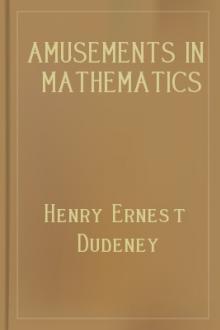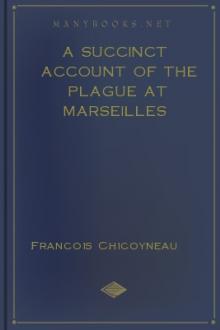Amusements in Mathematics, Henry Ernest Dudeney [books to read to be successful txt] 📗

- Author: Henry Ernest Dudeney
- Performer: 0486204731
Book online «Amusements in Mathematics, Henry Ernest Dudeney [books to read to be successful txt] 📗». Author Henry Ernest Dudeney
We therefore see how, by using the revolving card in Fig. 1, we may, without any difficulty, at once write out ten routes. And if we employ the cards in Figs. 2 and 3, we similarly obtain in each case ten other routes. These thirty routes are all that are possible. I do not give the actual proof that the three cards exhaust all the possible cases, but leave the reader to reason that out for himself. If he works out any route at haphazard, he will certainly find that it falls into one or other of the three categories.
255.—THE LEVEL PUZZLE.—solution
Let us confine our attention to the L in the top left-hand corner. Suppose we go by way of the E on the right: we must then go straight on to the V, from which letter the word may be completed in four ways, for there are four E's available through which we may reach an L. There are therefore four ways of reading through the right-hand E. It is also clear that there must be the same number of ways through the E that is immediately below our starting point. That makes eight. If, however, we take the third route through the E on the diagonal, we then have the option of any one of the three V's, by means of each of which we may complete the word in four ways. We can therefore spell LEVEL in twelve ways through the diagonal E. Twelve added to eight gives twenty readings, all emanating from the L in the top left-hand corner; and as the four corners are equal, the answer must be four times twenty, or eighty different ways.
256.—THE DIAMOND PUZZLE.—solution
There are 252 different ways. The general formula is that, for words of n letters (not palindromes, as in the case of the next puzzle), when grouped in this manner, there are always 2(n+1) - 4 different readings. This does not allow diagonal readings, such as you would get if you used instead such a word as DIGGING, where it would be possible to pass from one G to another G by a diagonal step.
257.—THE DEIFIED PUZZLE.—solution
The correct answer is 1,992 different ways. Every F is either a corner F or a side F—standing next to a corner in its own square of F's. Now, FIED may be read from a corner F in 16 ways; therefore DEIF may be read into a corner F also in 16 ways; hence DEIFIED may be read through a corner F in 16 × 16 = 256 ways. Consequently, the four corner F's give 4 × 256 = 1,024 ways. Then FIED may be read from a side F in 11 ways, and DEIFIED therefore in 121 ways. But there are eight side F's; consequently these give together 8 × 121 = 968 ways. Add 968 to 1,024 and we get the answer, 1,992.
In this form the solution will depend on whether the number of letters in the palindrome be odd or even. For example, if you apply the word NUN in precisely the same manner, you will get 64 different readings; but if you use the word NOON, you will only get 56, because you cannot use the same letter twice in immediate succession (since you must "always pass from one letter to another") or diagonal readings, and every reading must involve the use of the central N.
The reader may like to find for himself the general formula in this case, which is complex and difficult. I will merely add that for such a case as MADAM, dealt with in the same way as DEIFIED, the number of readings is 400.
258.—THE VOTERS' PUZZLE.—solution
THE number of readings here is 63,504, as in the case of "WAS IT A RAT I SAW" (No. 30, Canterbury Puzzles). The general formula is that for palindromic sentences containing 2n + 1 letters there are [4(2n - 1)]² readings.
259.—HANNAH'S PUZZLE.—solution
Starting from any one of the N's, there are 17 different readings of NAH, or 68 (4 times 17) for the 4 N's. Therefore there are also 68 ways of spelling HAN. If we were allowed to use the same N twice in a spelling, the answer would be 68 times 68, or 4,624 ways. But the conditions were, "always passing from one letter to another." Therefore, for every one of the 17 ways of spelling HAN with a particular N, there would be 51 ways (3 times 17) of completing the NAH, or 867 (17 times 51) ways for the complete word. Hence, as there are four N's to use in HAN, the correct solution of the puzzle is 3,468 (4 times 867) different ways.
260.—THE HONEYCOMB PUZZLE.—solution
The required proverb is, "There is many a slip 'twixt the cup and the lip." Start at the T on the outside at the bottom right-hand corner, pass to the H above it, and the rest is easy.
261.—THE MONK AND THE BRIDGES.—solution

The problem of the Bridges may be reduced to the simple diagram shown in illustration. The point M represents the Monk, the point I the Island, and the point Y the Monastery. Now the only direct ways from M to I are by the bridges a and b; the only direct ways from I to Y are by the bridges c and d; and there is a direct way from M to Y by the bridge e. Now, what we have to do is to count all the routes that will lead from M to Y, passing over all the bridges, a, b, c, d, and e once and once only. With the simple diagram under the eye it is quite easy, without any elaborate rule, to count these routes methodically. Thus, starting from a, b, we find there are only two ways of completing the route; with a, c, there are only two routes; with a, d, only two routes; and so on. It will be found that there are sixteen such routes in all, as in the following list:—
If the reader will transfer the letters indicating the bridges from the diagram to the corresponding bridges in the original illustration, everything will be quite obvious.
262.—THOSE FIFTEEN SHEEP.—solution
If we read the exact words of the writer in the cyclopædia, we find that we are not told that the pens were all necessarily empty! In fact, if the reader will refer back to the illustration, he will see that one sheep is already in one of the pens. It was just at this point that the wily farmer said to me, "Now I'm going to start placing the fifteen sheep." He thereupon proceeded to drive three from his flock into the already occupied pen, and then placed four sheep in each of the other three pens. "There," says he, "you have seen me place fifteen sheep in four pens so that there shall be the same number of sheep in every pen." I was, of course, forced to admit that he was perfectly correct, according to the exact wording of the question.
263.—KING ARTHUR'S KNIGHTS.—solution
On the second evening King Arthur arranged the knights and himself in the following order round the table: A, F, B, D, G, E, C. On the third evening they sat thus, A, E, B, G, C, F, D. He thus had B next but one to him on both occasions (the nearest possible), and G was the third from him at both sittings (the furthest position possible). No other way of sitting the knights would have been so satisfactory.
264.—THE CITY LUNCHEONS.—solution
The men may be grouped as follows, where each line represents a day and each column a table:—
Note that in every column (except in the case of the A's) all the letters descend cyclically in the same order, B, E, G, F, up to J, which is followed by B.
265.—A PUZZLE FOR CARD-PLAYERS.—solution
In the following solution each of the eleven lines represents a sitting, each column a table, and each pair of letters a pair of partners.
It will be seen that the letters B, C, D ...L descend cyclically. The solution given above is absolutely perfect in all respects. It will be found that every player has every other player once as his partner and twice as his opponent.
266.—A TENNIS TOURNAMENT.—solution
Call the men A, B, D, E, and their wives a, b, d, e. Then they may play as follows without any person ever playing twice





Comments (0)